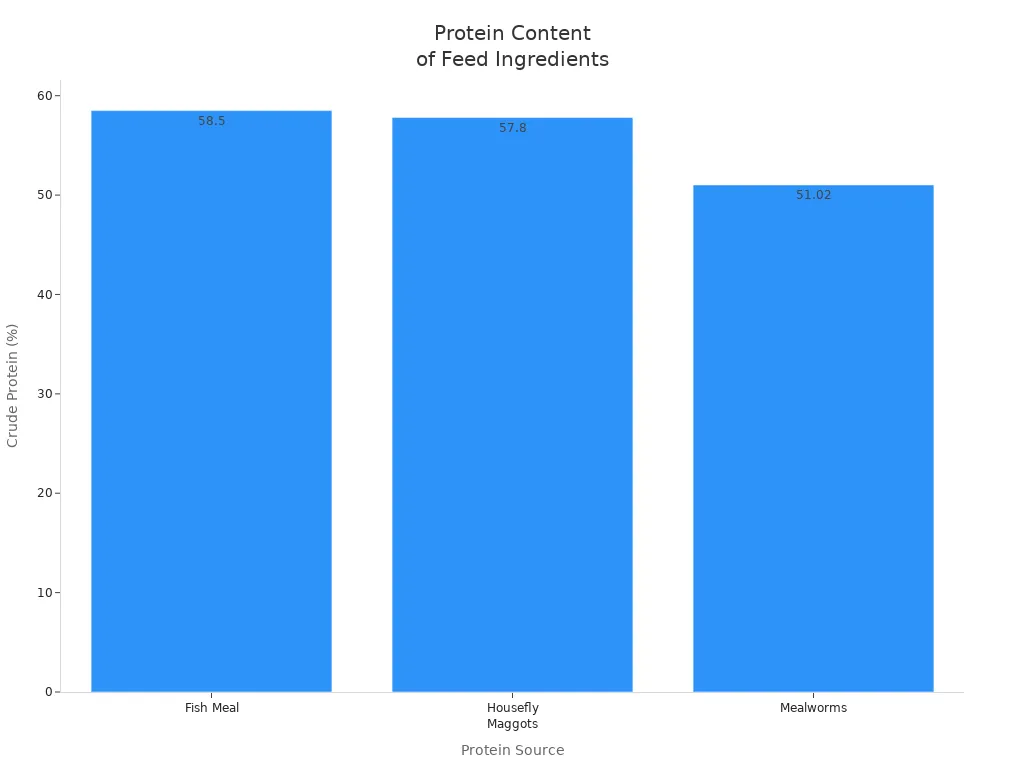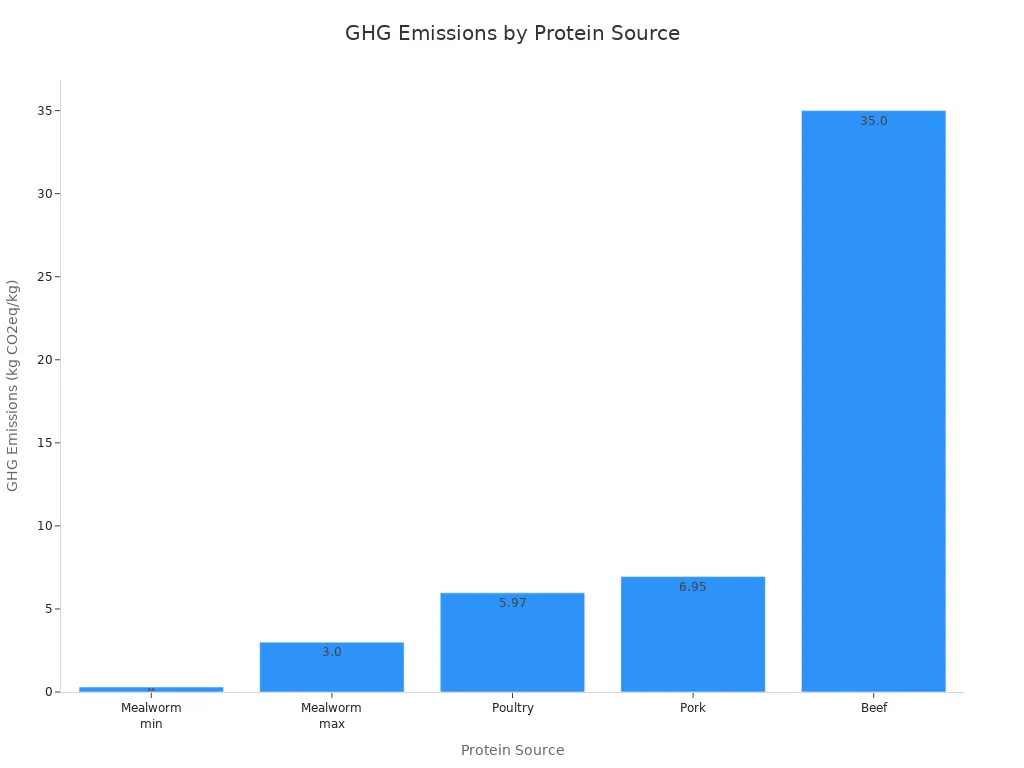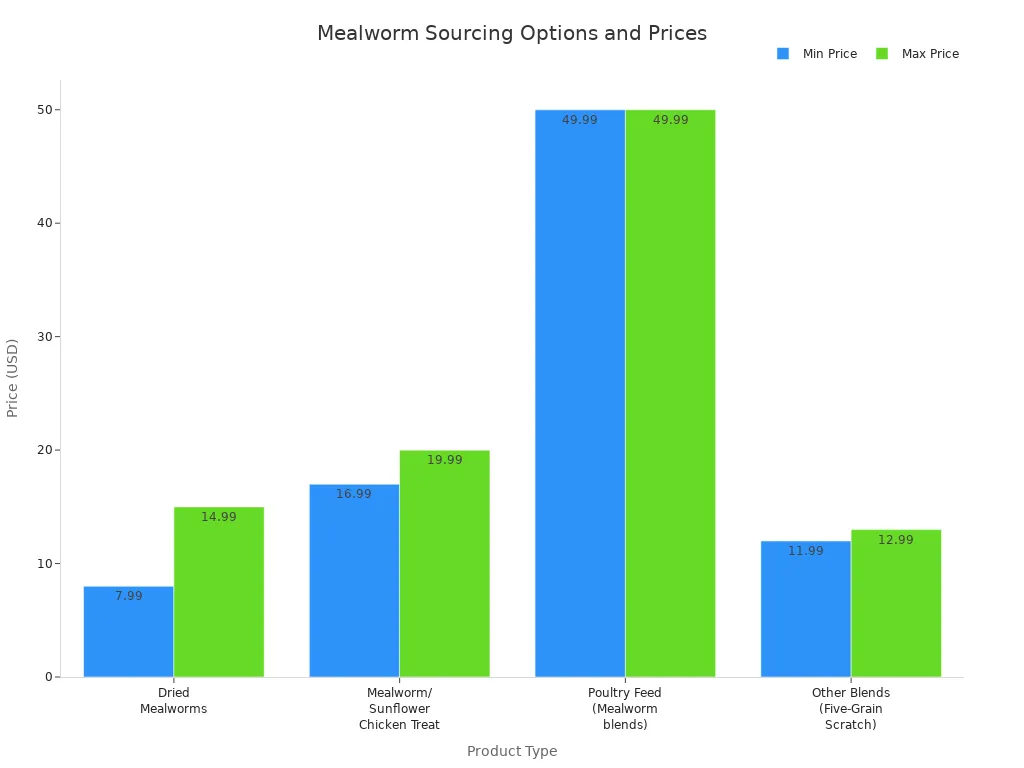
Chickens love a tasty snack, and mealworms never disappoint. They deliver a protein punch, making birds cluck with delight and feathers shine bright. Check out how much protein chickens need at different ages:
| Chicken Stage | Protein Percentage |
|---|---|
| Chicks | 20% |
| Growing Chickens | 17% |
| Adults | 16% |
| Molting/Cold Months | 18% |

Mealworms for Chicken Feed offer a natural way to meet these needs and keep your flock happy.
Key Takeaways
- Mealworms provide a natural, high-protein treat that helps chickens grow strong, lay better eggs, and maintain shiny feathers.
- Feeding mealworms encourages natural foraging behavior, reduces stress, and supports chickens’ immune and gut health.
- Using mealworms as chicken feed lowers environmental impact by saving land, water, and reducing greenhouse gases compared to traditional protein sources.
Mealworms for Chicken Feed: Nutrition and Health Benefits
High Protein and Essential Nutrients
Chickens crave protein, and mealworms deliver it in spades. Dried mealworms pack about 53% protein, making them a powerhouse for growing birds and egg-laying hens. This protein helps chickens build strong muscles, grow quickly, and stay healthy. The amino acid profile in mealworms reads like a champion’s checklist: lysine, leucine, isoleucine, and valine all show up in high amounts. These amino acids help chickens develop muscle and recover from stress.
| Amino Acid (g/kg dry) | Concentration in Mealworms |
|---|---|
| Lysine | 35.9 |
| Leucine | 31.5 |
| Isoleucine | 22.1 |
| Valine | 28.2 |
| Methionine | 10.1 |
| Tryptophan | 1.5 |
| Cysteine | 12.5 |
Mealworms for Chicken Feed also bring a treasure chest of vitamins and minerals. Chickens get B-vitamins, magnesium, phosphorus, potassium, sodium, zinc, iron, copper, and manganese in every bite. These nutrients keep birds energetic and support everything from bone strength to immune health. Compared to beef, mealworms offer more vitamins and even some fiber. Chickens digest mealworm protein as easily as soybean meal, so nothing goes to waste.
Tip: For best results, supplement calcium if mealworms make up a big part of the diet. This keeps eggshells strong and chickens happy.
Enhanced Egg Production and Feather Quality
Eggs from hens eating mealworms look like golden treasures. The yolks turn richer and brighter, and the shells become tougher. Studies show that hens fed insect meals, including mealworms, lay eggs with:
- Stronger shells
- Brighter, more colorful yolks
- Larger yolk size
- Improved taste and texture
Chickens also strut around with shinier, fuller feathers. The high protein and balanced amino acids in mealworms help birds grow new feathers during molting and keep their plumage looking sharp all year. Farmers notice fewer cracked eggs and more compliments on egg quality at the breakfast table.
Mealworms for Chicken Feed don’t just boost egg quality. They also help hens lay more eggs, especially during stressful times like molting or cold weather. The extra protein and nutrients give hens the energy they need to keep producing.
Supports Natural Foraging and Reduces Stress
Chickens love to hunt for bugs. Tossing mealworms into the coop turns feeding time into a fun game. Birds scratch, peck, and chase after their treats, just like they would in the wild. This natural foraging keeps chickens busy and happy.
Behavioral studies show that chickens spend up to 60% of their day foraging when given the chance. Mealworms encourage this activity, which helps reduce boredom and stress. Happy chickens peck each other less and show fewer bad habits like feather picking.
Note: Feeding mealworms during tough times—like molting, breeding, or hot summers—can help chickens cope with stress. The extra protein and fun foraging keep their spirits high.
Mealworms for Chicken Feed also support gut health and boost the immune system. Chickens eating mealworms show better disease resistance and healthier gut bacteria. The chitin in mealworms acts like a prebiotic, helping good bacteria grow and keeping harmful germs away.
Mealworms for Chicken Feed: Sustainability and Practical Use
Eco-Friendly and Resource-Efficient Protein Source
Mealworms for Chicken Feed bring a green twist to the coop. These tiny insects pack a big punch for the planet. Life Cycle Assessment studies show that mealworm farming creates much less greenhouse gas than raising chickens, pigs, or cows. For every kilogram of edible protein, mealworms produce about 20.4 kg of CO2-equivalent—up to 72% less than organic broiler chickens. They do not burp out methane like cows, and they need far less land and water. In fact, chicken protein takes two to three times more land and 50% more water than mealworms. Beef needs up to 14 times more land!
With mealworms, farmers shrink their carbon footprint and help the earth breathe easier.
Cost-Effectiveness and Sourcing Options
Chicken keepers love choices, and mealworms come in many forms. Dried mealworms, blends with grains, and even sunflower treats fill the shelves. Prices stay friendly, too. Check out this handy table:
| Product Type | Bag Size | Price Range (USD) | Description / Notes |
|---|---|---|---|
| Dried Mealworms | 3 lb | $7.99 – $14.99 | High protein treat, supports feather growth and wellbeing. |
| Mealworm/Sunflower Chicken Treat | 8 lb | $16.99 – $19.99 | Blend with sunflower seeds, cracked corn, peanuts, raisins, flax seed, calcium, vitamins A & D3. |
| Poultry Feed (Mealworm blends) | 5 lb | Up to $49.99 | Premium blends with grains, encourages natural foraging. |
| Other Blends (Five-Grain Scratch) | 10-12 lb | $11.99 – $12.99 | Grains, seeds, and Boonworms for a balanced treat. |

For the DIY crowd, raising mealworms at home costs less than a pizza night. A starter colony, a tub, and some bran set the stage for endless protein snacks.
How to Feed Mealworms to Chickens
Chickens gobble up mealworms in any form—live, dried, or mixed in treats. Live mealworms spark natural foraging and keep birds busy. Dried mealworms offer a protein boost and store well. Mixing both gives chickens fun and nutrition. Sprinkle mealworms on the ground, toss them in the run, or blend them into regular feed. Just remember, moderation is key. Too many mealworms can make chickens a little too plump. For best results, use mealworms as a treat or supplement, not the main course. Happy hens, healthy eggs, and a cleaner planet—now that’s a win for everyone!
Mealworms for Chicken Feed turn every flock into a powerhouse. Chickens grow faster and lay better eggs. Farmers see improved feed efficiency and no health issues, as shown below:
| Parameter | Effect with Mealworms |
|---|---|
| Body Weight Gain | Increased |
| Feed Efficiency | Improved |
| Health | No negative impact |
Sustainable, nutritious, and popular—these little bugs are the future of chicken feed!
FAQ
Can chickens eat mealworms every day?
Chickens can enjoy mealworms daily as a treat. Too many mealworms might make them chunky. Keep treats to about 10% of their diet for happy, healthy hens.
Do mealworms help chickens lay more eggs?
Yes! Mealworms give hens a protein boost. Hens often lay more eggs with stronger shells and brighter yolks. Farmers call it the “golden egg effect.” 🥚✨
Are dried or live mealworms better for chickens?
Both work great. Live mealworms spark foraging fun. Dried mealworms offer convenience and long shelf life. Chickens love both, so mix it up for extra excitement!


